Volume 2, issue 3
A PUBLICATION OF THE SDG (SUSTAINABLE DEVELOPMENT GOALS)
DEPARTMENT OF HOPE INTERACTIVE, DAMATURU, YOBE STATE, NORTHEAST NIGERIA
FROM THE EDITOR
It is my pleasure to introduce to you the first publication of the SDG department of Hope Interactive with special focus on food security and nutrition (Goal 2: Zero Hunger). The 2030 agenda for sustainable development is possible if we remain undistracted and focused on each goal with unflinching courage as we battle insecurity, global melt down, wars and pandemics. The SDG was adopted by the United Nations member states in 2015, which provides a shared blueprint for peace and prosperity for people and the planet, now and into the future. The 17 SDG goals are strategic thematic areas that we need to prioritize to ensure that people have the right to life with dignity. The activities of this department cuts across three LGAs in Yobe state namely Damaturu, Potiskum and Geidam LGA’s targeting the most vulnerable, who most times are victims of insurgency, GBV survivors, displaced persons etc. Hope Interactive uses the sphere project handbook in implementing its SGD goals. The sphere project hand book is a humanitarian charter, which spells out the core and minimum standards for humanitarian response and a set of protection principles. We also employ its two basic approaches: Rights based approach and beneficiary centered approach. We are also guided by the protection principles which require that we do no further harm; target the most vulnerable and ensure that communities recover in stable conditions.
Special thanks to every member of the SDG department for working tirelessly to implement projects/activities and to compile this.
I encourage Federal, state and local government MDAs to prioritize and speed up action on sustainable development, working with the peak of precision to achieve these noble goals. I would like to end with words of the 35th president of the United State of America, John F. Kenedy: “Never before has man had such capacity to control his own environment, to end thirst and hunger, to conquer poverty and disease, to banish illiteracy and massive human misery. We have the power to make this the best generation of mankind in the history of the world- or make it the last.”
The more we procrastinate qualitative implementation of these goals, the more time we lose and the existing achievements deteriorate before 2030. We must be calculative, firm and resolute in achieving these goals as stakeholders. Every step must be carefully outlined, well-crafted and intentionally sited for us to reap its cumulative impact.
Thank you.

Mshelia Birma, Executive Director
THE CONTEXT
The northeast region of Nigeria faces significant challenges in terms of food security and nutrition. The combination of ongoing conflict, displacement of populations, and limited access to resources has created a severe humanitarian crisis in the region, exacerbating the already existing issues related to food security and nutrition.
Insufficient Food Production: The conflict and insecurity in the northeast have disrupted agricultural activities, leading to decreased food production. Farming communities have been displaced, and their livelihoods have been severely affected. As a result, there is a lack of locally grown food, leading to increased dependence on external food sources.
Disrupted Food Supply Chains: The conflict and insecurity have also disrupted food supply chains, making it challenging to transport and distribute food to areas in need. This disruption further limits the availability and access to nutritious food in the region, particularly for vulnerable populations such as children, pregnant women, and the elderly.
Malnutrition and Health Impacts: The combination of limited food availability and access, along with the displacement of populations, has contributed to high levels of malnutrition in the northeast. Malnutrition rates, especially among children, are alarmingly high, leading to increased vulnerability to diseases and long-term health consequences. Lack of access to clean water and sanitation facilities further exacerbates the health impacts.
Limited Infrastructure and Services: The conflict has damaged infrastructure, including agricultural facilities, markets, and healthcare services. The lack of functional infrastructure hinders the ability to rebuild and sustainably address food security and nutrition challenges in the region. It also restricts the delivery of humanitarian aid and assistance.
Socioeconomic Vulnerability: The protracted conflict and displacement have resulted in a significant number of internally displaced persons (IDPs) in the northeast. Over the years there has been closure of markets and inability to travel to market places which has impacted economic activities in the region. The IDPs often live in overcrowded camps or host communities with limited resources and opportunities. This leads to increased vulnerability to food insecurity, malnutrition, and poverty, creating a cycle of deprivation. The recent removal of fuel subsidy has further plunged families into economic crises with cost of food stuff rising about 300%.
Disruption by flood: On the 11th of July 2022, heavy rain and flash flood swept across Gujba, Bade, Damaturu, Fika, Nguru, Yususfari, Potiskum, Gulani and Tarmuwa LGAs in Yobe state which led to displacement, isolation of households, destruction of farm land, properties, shelter etc. The secondary effect of this natural disaster has been food insecurity since most farmers are unable to use their farmland after the water receded because of a massive deposit of sand, while others are unable to return to their homes.

GLOBAL HUNGER CRISIS
The latest Publication of global food insecurity by WFP shows that up to 783 million people – one in ten of the world’s population – still go to bed hungry each night. WFP estimates – from 79 of the countries where it works (and where data is available) – indicate that more than 345 million people are facing high levels of food insecurity in 2023. This is an increase of almost 200 million since early 2020 (pre-COVID-19 levels). Over 40 million people across 51 countries are in Emergency or worse levels of acute food insecurity in 2023. Without urgent life-saving action, they are at risk of falling into catastrophe or famine conditions. Furthermore, 45 million children under 5 years of age are estimated to suffer from acute malnutrition. A deadly combination of conflict, economic shocks, climate extremes and soaring fertilizer prices is at the root of soaring numbers. The economic fallout of the COVID-19 pandemic, and then the war in Ukraine, has pushed prices up and put food out of reach for millions of people across the world. At the same time, high fertilizer prices are causing a falling production of maize, rice, soybean and wheat.
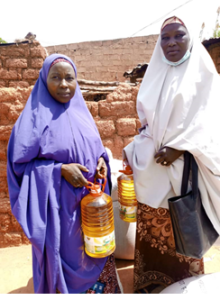
FOOD INSECURITY AND MALNUTRITION IN CENTRAL AND WEST AFRICA
According to the WFP statistics as published on the 18th of April 2023, acute food insecurity is on track to reach a 10-Year high in West and Central Africa by June of this year. A new study also shows with a worrying expansion of food insecurity into coastal countries, and catastrophic levels of hunger hitting conflict affected areas of Burkina Faso and Mali where humanitarian assistance is severely hindered by insecurity.
For the first time in the Sahel, 45,000 people are forecast to experience catastrophic (Phase 5) level of hunger – one step away from famine, including 42,000 in Burkina Faso and 2,500 in Mali. The combined effects of conflict, climate shocks, COVID-19, and high food prices continue to drive up hunger and malnutrition in the region, with the number of people lacking regular access to safe and nutritious food projected to rise to 48 million during the June-August 2023 lean season according to the March 2023 Cadre Harmonisé food security analysis – a fourfold increase in the last five years. The results also confirm a longer-term trend towards a geographic expansion of food insecurity in the region. “The spiralling food security and nutrition situation in Western Africa is just heart-breaking,” said Chris Nikoi, WFP’s Regional Director for Western Africa The already grim nutritional situation for communities across the region is also on the slide with 16.5 million children under 5 set to face acute malnutrition in 2023, including 4.8 million children set to suffer from the debilitating severe form (SAM). This is an 83 percent rise in global acute malnutrition (GAM) compared to the 2015-2022 average.
FOOD INSECURITY IN NIGERIA
With over 200 million people, Nigeria is the most populated country in Africa and the seventh in the world. The annual growth rate of the population is approximately 2.7 per cent, and more than half are under 30 years of age. Nigeria is the tenth-largest producer of crude oil in the world and achieved lower-middle-income status in 2014. However, conflict in its northeast region has displaced over 3 million people and left another 4.1 million People insecure in Borno, Adamawa and Yobe states. Three million of them are in Borno State, the epicenter of insurgency. The country’s human-development indicators are poor. Persistent poverty affects more than half the population, most severely in the northeast and northwest regions. In addition, Nigeria is also subject to periodic droughts and floods. This has had an adverse impact on agricultural output and increased the vulnerability of populations, especially in rural areas.
The alarming rise in hunger across the country has necessitated the New President, who was sworn into office barely 2 months ago to declare a state of emergency on food security in Nigeria on the 14th of July, 2023 this is in an effort to help the scary situation at hand.
FOOD SECURITY STATISTICS IN NORTHEAST NIGERIA
According to the 2021 Global Report on Food Crises, an estimated 3.4 million people in the three most affected states of Borno, Adamawa, and Yobe in Northeast Nigeria were facing acute food insecurity, with many in Emergency (IPC Phase 4) and Crisis (IPC Phase 3) levels. This indicates that they require urgent humanitarian assistance to meet their basic food need
The latest report published by the World Food Programme (WFP) shows that 8.4 million People are food insecure in northeast Nigeria 70% of people nationwide live below the poverty line Over 3 million people internally displaced in Borno, Yobe and Adamawa states.
BORNO STATE
The April 2023 Humanitarian Situation Monitoring (HSM) report indicates worrying food consumption deficits and limited diet diversity in extremely hard-to-reach areas of the state. About 45.6% of the households surveyed said they struggled to have sufficient food intake and 68.5% said they experienced crisis or higher levels – Phase 3 and above – of food deprivation and hunger.
The HSM also showed that 37.1% of the households surveyed relied on crisis coping strategies to meet their food needs, which heightened economic vulnerability due to the negative impact on the future productivity of the most affected households.
There is a worrying level of acute malnutrition among new arrivals from extremely hard-to-reach areas, with most entering Phase 4 of the Integrated Acute Malnutrition Phase Classification, with overall global acute malnutrition (GAM) rates of 20.9 per cent and severe acute malnutrition (SAM) rates of 8.2 per cent, which are above the emergency threshold. The high levels of acute malnutrition indicate an extremely stressed population in relation to food insecurity, with inadequate water and sanitation access, and poor health conditions among the underlying causes of acute malnutrition.

YOBE STATE
The Situation is not different in Yobe as revealed by the March 2023 CH analysis. The analysis shows that the number of people in need of food assistance in Yobe State reached 800,000 for the period of March to May and 1.2 million for the period of June to August.
ABOUT HOPE INTERACTIVE SDGs DEPARTMENT
The UN SDGs are a universal set of 17 goals with 169 corresponding targets that were agreed upon by the UN member countries to solve some of humanity’s biggest challenges within 15 years. They aim to end poverty and hunger, increase access to education, address migration, combat climate change, and reduce inequality by 2030 as published by World Design Organization (WDO).
Nigeria is one of the countries that presented its Voluntary National Review (VNR) IN 2019 AND 2020 on the implementation of the SDGs at the high-level political forum on Sustainable Development (HLPF).
In 2020, Nigeria ranked 160 on the 2020 world’s SDG Index. The government affirmed that Nigeria’s current development priorities and objectives are focused on achieving the SDGs.
As a way to break down silos and effectively collaborate around a common National and universal Development Agenda, Hope Interactive being a NNGO in Nigeria with a vision to promote a healthy and Sustainable future for People in Nigeria by diminishing poverty, through capacity building in various spheres of human development and other forms of needed support, birthed the SDGs Department which is saddled with the responsibility of employing every means in line with the National and UN SDGs policies to complement the implementation of the Sustainable Development Goals across its spheres of operation and access and also to Anchor collaboration with other organizations and departments outside and within her organization respectively, which is a practical expression of the 17th UN Sustainable Development Goal. This is all towards achieving the bigger goals.
ACTIVITIES
DAMATURU LGA
The Victims Help Center (VHC) identified a survivor of Domestic Violence in Damaturu LGA and then made a plea with the women networks of Potiskum LGA who are receiving livelihood support from world food Programme to voluntarily contribute from the grain support and Vegetable oil given to them to support the survivor and they contributed willingly seeing that the survivor is a fellow woman who has no food to eat with her children because she was divorce from the husband who does not take care of her and the children. The picture shows WFPSDI team giving the survivor the support from the women networks.

THE executive Director of WFPSDI handing food support to a survivor (HI/WFP project)
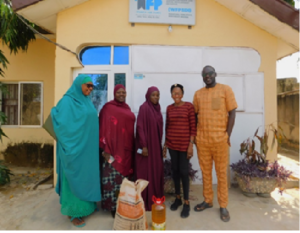
GROUP PICTURE SHOWING HI/WFPSDI VICTIMS HELP CENTER TEAM WITH SURVIVOR OF DOMESTIC
VIOLENCE AT DAMATURU LGA (HI/WFP project)
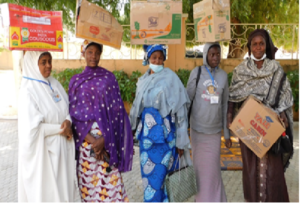
Women beneficiaries of food support from Hope Interactive Damaturu
POSTISKUM LGA:
LIVELIHOOD SUPPORT RECEIVED BY WOMEN NETWORKS AT POTISKUM LGA FROM WORLD FOOD PROGRAMME
As a result of the partnership between HI and JDPH, the women for peace networks in Nahuta, Rugar Fulani, Tandari, Jigawa, Afghanistan communities are received livelihood support on a WFP funded project, which has provided the women with food security and adequate diet over a period of time. The women confessed that the intervention was timely and provided them a high level of stability to focus more on other family and societal matters. A total of 125 women benefitted from this intervention.

CROSS SECTION WOMEN GROUPS IN POTISKUM LGA WHO RECEIVED LIVELIHOOD SUPPORT FROM JDPH IN
PARTNERHIP WITH WFP

CROSS SECTION OF WOMEN GROUPS AT POTSIKUM LGA AFTER RECEIVING LIVELIHOOD SUPPORT CARDS FROM JDPH/WFP
GEIDAM LGA
SUPPORT FOR BENEFICIARIES AT GEIDAM LGA
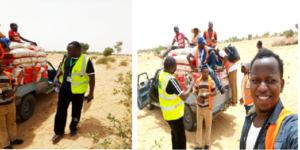
HOPE INTERACTIVE STAFF DURING FOOD DISTRIBUTION DURING RAMADAN AT KUSUR,DAMAKARWA ANJIWANGO
COMMUNITIES GEIDAM LGA YOBE STATE
With the recurrent incursions and indiscriminate killings by the insurgents, locals are unable to plant and harvest their crops, and as a result of this, locals have been plunged into food insecurity. 100 households benefitted from this intervention in Geidam LGA.

HI STAFF TAKING ATTENDANCE DURING RICE DISTRIBUTION AT GEIDAM LGA YOBE STATE.

IDENTIFICATION AND SELECTION OF BENEFICIARIES AT KUSUR, DAMAKARWA AND ANJIWANGO GEIDAM LGA
DAMATURU LGA
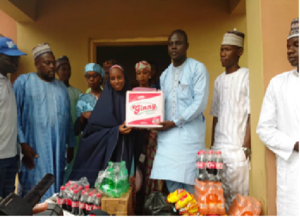
EID-EIL KABIR FOOD SUPPORT TO OVCS IN YETIM CARE FOUNDATION
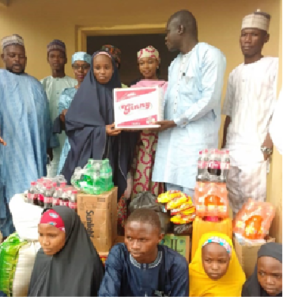
Front view of the beneficiaries And HI Staff
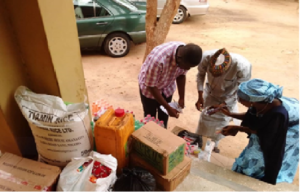
Food support arrived at YETIM Care Foundation Orphanage from Hope Interactive
Hope interactive in collaboration with old students of LPS, 2013 class organized an event to commemorate the Eid celebration with orphans and vulnerable children in Yetim care foundation. The OVCs engaged in quiz, games and recievd food support. The Executive Director of Yetim foundation received the items on behalf of the OVCs and immensely thanked Hope Interactive and LEOSA 2013 class for remembering the VCs in Yetim Foundation.
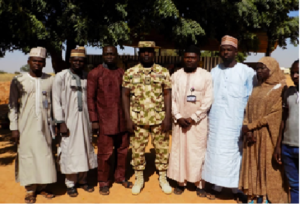
HOPE INTERACTIVE ADVOCACY VISIT TO THE TASK FORCE COMMAND AT GEIDAM LGA DURING FOOD DISTRIBUTION
DAMATURU LGA
As part of her commitment towards supporting the achievement of the 2nd goal of the global sustainable development goal (SDG) which aim at ensuring access to self-nutritious, sufficient food for all, the HI SDG department collaborated with the protection department to support some vulnerable women with maize and some token of money in order to help cushion the effect of hunger fuelled by the fuel subsidy removal in Nigeria which is responsible for the hike in the prices of commodities including food in the country especially the Northeast which is under state of emergency and had rendered so many people vulnerable, hungry and in need of food for survival.
In the light of the protection department which is in the midst of observing the sixteen days of activism, the protection team in collaboration with the Food security and Nutrition team delivered a lecture to the beneficiaries; where they were lectured on sensitive topics that relate to violence against women and girls especially the violence against People Prohibition (VAPP) law.
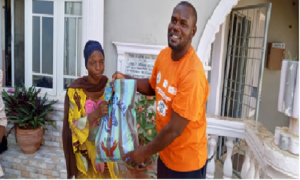
Presentation of maize to one of the beneficiaries
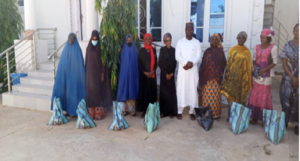
A photograph of beneficiaries and HI staff
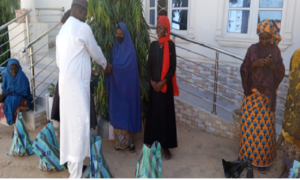
Distribution of token of monetary support to beneficiaries

Another view of beneficiaries and HI staff

A lecture session ongoing
PARTNERS:
- Creative Associates International: North East Regional Initiative (NERI)
- Justice Development peace and health Initiative (JDPH).
- Leaders Private School Old Students Association (LEOSA CLASS OF 2013)
- Women for Peace and Social Development Initiative (WFPSDI)
CONTRIBUTORS

Andrew Wayuta (Programs manager and Head of Department)

Irimiya Ghirama (Program officer and counsellor)

Stephen Gwary (M&E and Health officer)
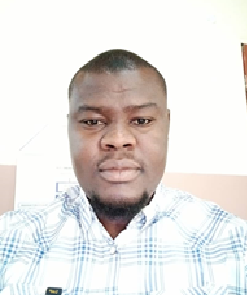
Abdulhamid Usman (Programs and Field officer)
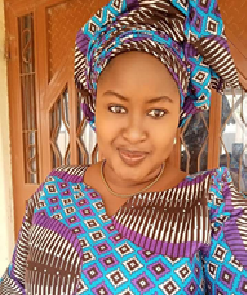
Tarhyel Agba Maiva (M&E Officer and Case Manager)
REFERENCES
United Nations Department of Economic and Social Affairs; Division for Sustainable Development Goals (DSDG) 2023.


Volume 2, issue 3
A PUBLICATION OF THE SDG (SUSTAINABLE DEVELOPMENT GOALS)
DEPARTMENT OF HOPE INTERACTIVE, DAMATURU, YOBE STATE, NORTHEAST NIGERIA
FROM THE EDITOR
It is my pleasure to introduce to you the first publication of the SDG department of Hope Interactive with special focus on food security and nutrition (Goal 2: Zero Hunger). The 2030 agenda for sustainable development is possible if we remain undistracted and focused on each goal with unflinching courage as we battle insecurity, global melt down, wars and pandemics. The SDG was adopted by the United Nations member states in 2015, which provides a shared blueprint for peace and prosperity for people and the planet, now and into the future. The 17 SDG goals are strategic thematic areas that we need to prioritize to ensure that people have the right to life with dignity. The activities of this department cuts across three LGAs in Yobe state namely Damaturu, Potiskum and Geidam LGA’s targeting the most vulnerable, who most times are victims of insurgency, GBV survivors, displaced persons etc. Hope Interactive uses the sphere project handbook in implementing its SGD goals. The sphere project hand book is a humanitarian charter, which spells out the core and minimum standards for humanitarian response and a set of protection principles. We also employ its two basic approaches: Rights based approach and beneficiary centered approach. We are also guided by the protection principles which require that we do no further harm; target the most vulnerable and ensure that communities recover in stable conditions.
Special thanks to every member of the SDG department for working tirelessly to implement projects/activities and to compile this.
I encourage Federal, state and local government MDAs to prioritize and speed up action on sustainable development, working with the peak of precision to achieve these noble goals. I would like to end with words of the 35th president of the United State of America, John F. Kenedy: “Never before has man had such capacity to control his own environment, to end thirst and hunger, to conquer poverty and disease, to banish illiteracy and massive human misery. We have the power to make this the best generation of mankind in the history of the world- or make it the last.”
The more we procrastinate qualitative implementation of these goals, the more time we lose and the existing achievements deteriorate before 2030. We must be calculative, firm and resolute in achieving these goals as stakeholders. Every step must be carefully outlined, well-crafted and intentionally sited for us to reap its cumulative impact.
Thank you.
Mshelia Birma, Executive Director
THE CONTEXT
The northeast region of Nigeria faces significant challenges in terms of food security and nutrition. The combination of ongoing conflict, displacement of populations, and limited access to resources has created a severe humanitarian crisis in the region, exacerbating the already existing issues related to food security and nutrition.
Insufficient Food Production: The conflict and insecurity in the northeast have disrupted agricultural activities, leading to decreased food production. Farming communities have been displaced, and their livelihoods have been severely affected. As a result, there is a lack of locally grown food, leading to increased dependence on external food sources.
Disrupted Food Supply Chains: The conflict and insecurity have also disrupted food supply chains, making it challenging to transport and distribute food to areas in need. This disruption further limits the availability and access to nutritious food in the region, particularly for vulnerable populations such as children, pregnant women, and the elderly.
Malnutrition and Health Impacts: The combination of limited food availability and access, along with the displacement of populations, has contributed to high levels of malnutrition in the northeast. Malnutrition rates, especially among children, are alarmingly high, leading to increased vulnerability to diseases and long-term health consequences. Lack of access to clean water and sanitation facilities further exacerbates the health impacts.
Limited Infrastructure and Services: The conflict has damaged infrastructure, including agricultural facilities, markets, and healthcare services. The lack of functional infrastructure hinders the ability to rebuild and sustainably address food security and nutrition challenges in the region. It also restricts the delivery of humanitarian aid and assistance.
Socioeconomic Vulnerability: The protracted conflict and displacement have resulted in a significant number of internally displaced persons (IDPs) in the northeast. Over the years there has been closure of markets and inability to travel to market places which has impacted economic activities in the region. The IDPs often live in overcrowded camps or host communities with limited resources and opportunities. This leads to increased vulnerability to food insecurity, malnutrition, and poverty, creating a cycle of deprivation. The recent removal of fuel subsidy has further plunged families into economic crises with cost of food stuff rising about 300%.
Disruption by flood: On the 11th of July 2022, heavy rain and flash flood swept across Gujba, Bade, Damaturu, Fika, Nguru, Yususfari, Potiskum, Gulani and Tarmuwa LGAs in Yobe state which led to displacement, isolation of households, destruction of farm land, properties, shelter etc. The secondary effect of this natural disaster has been food insecurity since most farmers are unable to use their farmland after the water receded because of a massive deposit of sand, while others are unable to return to their homes.
GLOBAL HUNGER CRISIS
The latest Publication of global food insecurity by WFP shows that up to 783 million people – one in ten of the world’s population – still go to bed hungry each night. WFP estimates – from 79 of the countries where it works (and where data is available) – indicate that more than 345 million people are facing high levels of food insecurity in 2023. This is an increase of almost 200 million since early 2020 (pre-COVID-19 levels). Over 40 million people across 51 countries are in Emergency or worse levels of acute food insecurity in 2023. Without urgent life-saving action, they are at risk of falling into catastrophe or famine conditions. Furthermore, 45 million children under 5 years of age are estimated to suffer from acute malnutrition. A deadly combination of conflict, economic shocks, climate extremes and soaring fertilizer prices is at the root of soaring numbers. The economic fallout of the COVID-19 pandemic, and then the war in Ukraine, has pushed prices up and put food out of reach for millions of people across the world. At the same time, high fertilizer prices are causing a falling production of maize, rice, soybean and wheat.
FOOD INSECURITY AND MALNUTRITION IN CENTRAL AND WEST AFRICA
According to the WFP statistics as published on the 18th of April 2023, acute food insecurity is on track to reach a 10-Year high in West and Central Africa by June of this year. A new study also shows with a worrying expansion of food insecurity into coastal countries, and catastrophic levels of hunger hitting conflict affected areas of Burkina Faso and Mali where humanitarian assistance is severely hindered by insecurity.
For the first time in the Sahel, 45,000 people are forecast to experience catastrophic (Phase 5) level of hunger – one step away from famine, including 42,000 in Burkina Faso and 2,500 in Mali. The combined effects of conflict, climate shocks, COVID-19, and high food prices continue to drive up hunger and malnutrition in the region, with the number of people lacking regular access to safe and nutritious food projected to rise to 48 million during the June-August 2023 lean season according to the March 2023 Cadre Harmonisé food security analysis – a fourfold increase in the last five years. The results also confirm a longer-term trend towards a geographic expansion of food insecurity in the region. “The spiralling food security and nutrition situation in Western Africa is just heart-breaking,” said Chris Nikoi, WFP’s Regional Director for Western Africa The already grim nutritional situation for communities across the region is also on the slide with 16.5 million children under 5 set to face acute malnutrition in 2023, including 4.8 million children set to suffer from the debilitating severe form (SAM). This is an 83 percent rise in global acute malnutrition (GAM) compared to the 2015-2022 average.
FOOD INSECURITY IN NIGERIA
With over 200 million people, Nigeria is the most populated country in Africa and the seventh in the world. The annual growth rate of the population is approximately 2.7 per cent, and more than half are under 30 years of age. Nigeria is the tenth-largest producer of crude oil in the world and achieved lower-middle-income status in 2014. However, conflict in its northeast region has displaced over 3 million people and left another 4.1 million People insecure in Borno, Adamawa and Yobe states. Three million of them are in Borno State, the epicenter of insurgency. The country’s human-development indicators are poor. Persistent poverty affects more than half the population, most severely in the northeast and northwest regions. In addition, Nigeria is also subject to periodic droughts and floods. This has had an adverse impact on agricultural output and increased the vulnerability of populations, especially in rural areas.
The alarming rise in hunger across the country has necessitated the New President, who was sworn into office barely 2 months ago to declare a state of emergency on food security in Nigeria on the 14th of July, 2023 this is in an effort to help the scary situation at hand.
FOOD SECURITY STATISTICS IN NORTHEAST NIGERIA
According to the 2021 Global Report on Food Crises, an estimated 3.4 million people in the three most affected states of Borno, Adamawa, and Yobe in Northeast Nigeria were facing acute food insecurity, with many in Emergency (IPC Phase 4) and Crisis (IPC Phase 3) levels. This indicates that they require urgent humanitarian assistance to meet their basic food need
The latest report published by the World Food Programme (WFP) shows that 8.4 million People are food insecure in northeast Nigeria 70% of people nationwide live below the poverty line Over 3 million people internally displaced in Borno, Yobe and Adamawa states.
BORNO STATE
The April 2023 Humanitarian Situation Monitoring (HSM) report indicates worrying food consumption deficits and limited diet diversity in extremely hard-to-reach areas of the state. About 45.6% of the households surveyed said they struggled to have sufficient food intake and 68.5% said they experienced crisis or higher levels – Phase 3 and above – of food deprivation and hunger.
The HSM also showed that 37.1% of the households surveyed relied on crisis coping strategies to meet their food needs, which heightened economic vulnerability due to the negative impact on the future productivity of the most affected households.
There is a worrying level of acute malnutrition among new arrivals from extremely hard-to-reach areas, with most entering Phase 4 of the Integrated Acute Malnutrition Phase Classification, with overall global acute malnutrition (GAM) rates of 20.9 per cent and severe acute malnutrition (SAM) rates of 8.2 per cent, which are above the emergency threshold. The high levels of acute malnutrition indicate an extremely stressed population in relation to food insecurity, with inadequate water and sanitation access, and poor health conditions among the underlying causes of acute malnutrition.
YOBE STATE
The Situation is not different in Yobe as revealed by the March 2023 CH analysis. The analysis shows that the number of people in need of food assistance in Yobe State reached 800,000 for the period of March to May and 1.2 million for the period of June to August.
ABOUT HOPE INTERACTIVE SDGs DEPARTMENT
The UN SDGs are a universal set of 17 goals with 169 corresponding targets that were agreed upon by the UN member countries to solve some of humanity’s biggest challenges within 15 years. They aim to end poverty and hunger, increase access to education, address migration, combat climate change, and reduce inequality by 2030 as published by World Design Organization (WDO).
Nigeria is one of the countries that presented its Voluntary National Review (VNR) IN 2019 AND 2020 on the implementation of the SDGs at the high-level political forum on Sustainable Development (HLPF).
In 2020, Nigeria ranked 160 on the 2020 world’s SDG Index. The government affirmed that Nigeria’s current development priorities and objectives are focused on achieving the SDGs.
As a way to break down silos and effectively collaborate around a common National and universal Development Agenda, Hope Interactive being a NNGO in Nigeria with a vision to promote a healthy and Sustainable future for People in Nigeria by diminishing poverty, through capacity building in various spheres of human development and other forms of needed support, birthed the SDGs Department which is saddled with the responsibility of employing every means in line with the National and UN SDGs policies to complement the implementation of the Sustainable Development Goals across its spheres of operation and access and also to Anchor collaboration with other organizations and departments outside and within her organization respectively, which is a practical expression of the 17th UN Sustainable Development Goal. This is all towards achieving the bigger goals.
ACTIVITIES
DAMATURU LGA
The Victims Help Center (VHC) identified a survivor of Domestic Violence in Damaturu LGA and then made a plea with the women networks of Potiskum LGA who are receiving livelihood support from world food Programme to voluntarily contribute from the grain support and Vegetable oil given to them to support the survivor and they contributed willingly seeing that the survivor is a fellow woman who has no food to eat with her children because she was divorce from the husband who does not take care of her and the children. The picture shows WFPSDI team giving the survivor the support from the women networks.
THE executive Director of WFPSDI handing food support to a survivor (HI/WFP project)
GROUP PICTURE SHOWING HI/WFPSDI VICTIMS HELP CENTER TEAM WITH SURVIVOR OF DOMESTIC
VIOLENCE AT DAMATURU LGA (HI/WFP project)
Women beneficiaries of food support from Hope Interactive Damaturu
POSTISKUM LGA:
LIVELIHOOD SUPPORT RECEIVED BY WOMEN NETWORKS AT POTISKUM LGA FROM WORLD FOOD PROGRAMME
As a result of the partnership between HI and JDPH, the women for peace networks in Nahuta, Rugar Fulani, Tandari, Jigawa, Afghanistan communities are received livelihood support on a WFP funded project, which has provided the women with food security and adequate diet over a period of time. The women confessed that the intervention was timely and provided them a high level of stability to focus more on other family and societal matters. A total of 125 women benefitted from this intervention.
CROSS SECTION WOMEN GROUPS IN POTISKUM LGA WHO RECEIVED LIVELIHOOD SUPPORT FROM JDPH IN
PARTNERHIP WITH WFP
CROSS SECTION OF WOMEN GROUPS AT POTSIKUM LGA AFTER RECEIVING LIVELIHOOD SUPPORT CARDS FROM JDPH/WFP
GEIDAM LGA
SUPPORT FOR BENEFICIARIES AT GEIDAM LGA
HOPE INTERACTIVE STAFF DURING FOOD DISTRIBUTION DURING RAMADAN AT KUSUR,DAMAKARWA ANJIWANGO
COMMUNITIES GEIDAM LGA YOBE STATE
With the recurrent incursions and indiscriminate killings by the insurgents, locals are unable to plant and harvest their crops, and as a result of this, locals have been plunged into food insecurity. 100 households benefitted from this intervention in Geidam LGA.
HI STAFF TAKING ATTENDANCE DURING RICE DISTRIBUTION AT GEIDAM LGA YOBE STATE.
IDENTIFICATION AND SELECTION OF BENEFICIARIES AT KUSUR, DAMAKARWA AND ANJIWANGO GEIDAM LGA
DAMATURU LGA
EID-EIL KABIR FOOD SUPPORT TO OVCS IN YETIM CARE FOUNDATION
Front view of the beneficiaries And HI Staff
Food support arrived at YETIM Care Foundation Orphanage from Hope Interactive
Hope interactive in collaboration with old students of LPS, 2013 class organized an event to commemorate the Eid celebration with orphans and vulnerable children in Yetim care foundation. The OVCs engaged in quiz, games and recievd food support. The Executive Director of Yetim foundation received the items on behalf of the OVCs and immensely thanked Hope Interactive and LEOSA 2013 class for remembering the VCs in Yetim Foundation.
HOPE INTERACTIVE ADVOCACY VISIT TO THE TASK FORCE COMMAND AT GEIDAM LGA DURING FOOD DISTRIBUTION
DAMATURU LGA
As part of her commitment towards supporting the achievement of the 2nd goal of the global sustainable development goal (SDG) which aim at ensuring access to self-nutritious, sufficient food for all, the HI SDG department collaborated with the protection department to support some vulnerable women with maize and some token of money in order to help cushion the effect of hunger fuelled by the fuel subsidy removal in Nigeria which is responsible for the hike in the prices of commodities including food in the country especially the Northeast which is under state of emergency and had rendered so many people vulnerable, hungry and in need of food for survival.
In the light of the protection department which is in the midst of observing the sixteen days of activism, the protection team in collaboration with the Food security and Nutrition team delivered a lecture to the beneficiaries; where they were lectured on sensitive topics that relate to violence against women and girls especially the violence against People Prohibition (VAPP) law.
Presentation of maize to one of the beneficiaries
A photograph of beneficiaries and HI staff
Distribution of token of monetary support to beneficiaries
Another view of beneficiaries and HI staff
A lecture session ongoing
PARTNERS:
CONTRIBUTORS
Andrew Wayuta (Programs manager and Head of Department)
Irimiya Ghirama (Program officer and counsellor)
Stephen Gwary (M&E and Health officer)
Abdulhamid Usman (Programs and Field officer)
Tarhyel Agba Maiva (M&E Officer and Case Manager)
REFERENCES
United Nations Department of Economic and Social Affairs; Division for Sustainable Development Goals (DSDG) 2023.